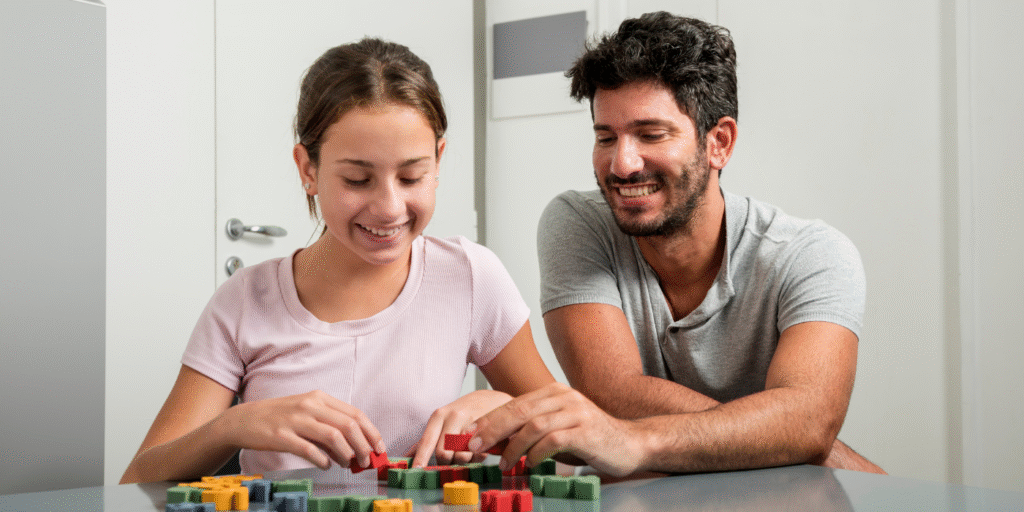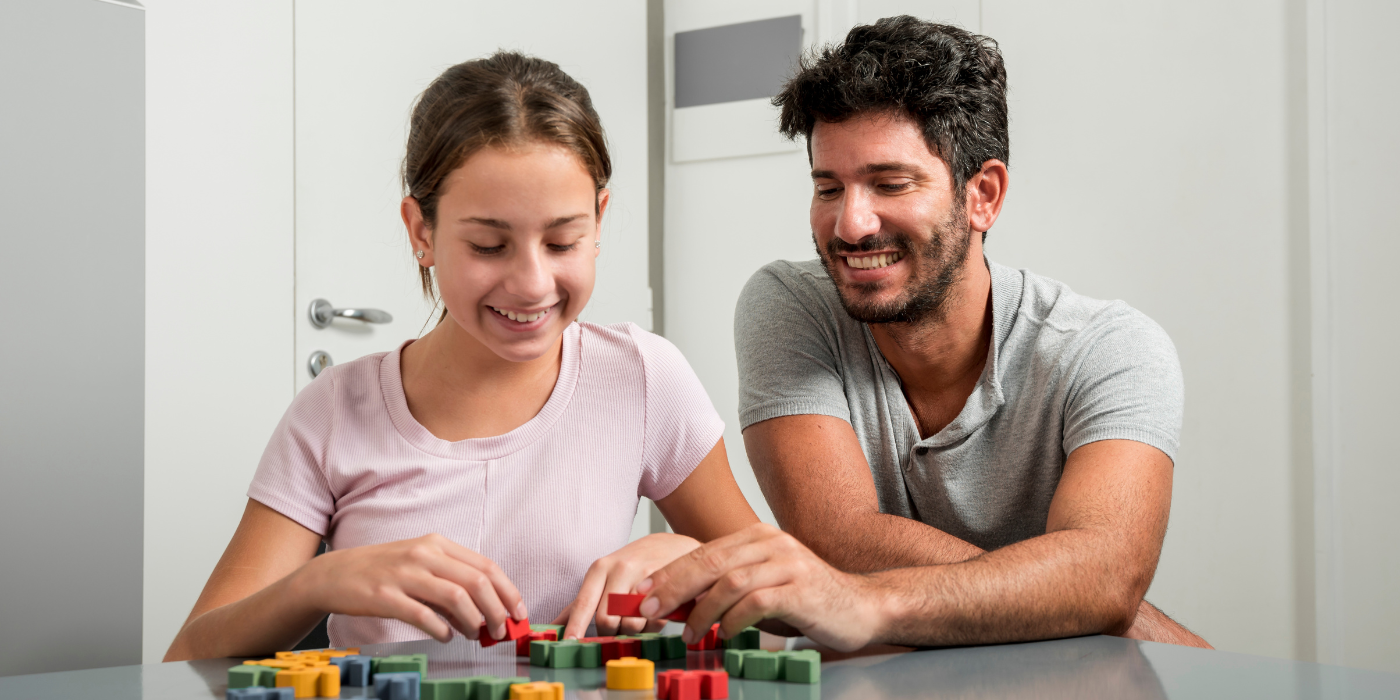P
Playtime is not just about fun; it is a powerful tool for your child’s growth and development. Through creative and purposeful play, parents can turn ordinary moments into educational adventures. Here is how you can harness the power of play to make learning engaging and enjoyable for your little ones.
Understanding the Importance of Play:
Play as a Learning Tool:
Play is a child’s language, and it is through play that they explore, experiment, and make sense of the world around them. Understanding the educational potential of play helps parents integrate learning seamlessly into their child’s daily activities.
Benefits of Play-Based Learning:
Cognitive Development: Enhances problem-solving skills and critical thinking.
Social Skills: Fosters cooperation, communication, and empathy.
Motor Skills: Develops both fine and gross motor skills through physical play.
Creativity: Encourages imagination and innovation.
- Playtime Essentials: Creating an Enriching Environment
A. Crafting a Safe and Exciting Play Space
The foundation of learning through play is a well-designed environment. Think of a room filled with colours, interactive displays, and educational toys strategically placed. This space becomes a haven where your child’s imagination flourishes, and their curiosity comes alive.
Safety First:
Ensure the play area is free from hazards with soft surfaces, child-friendly furniture, and rounded corners for a secure play environment.
B. Balancing Fun and Learning
The key to successful play is finding the right balance between free play and guided activities.
Free Play:
Allow your child the freedom to explore, invent scenarios, and follow their instincts in an open-ended space.
Structured Play:
Introduce intentional learning with activities designed to aid skill development and cognitive growth. Puzzles, counting games, and other guided activities can add a purposeful element to play.
C. Fostering Social Skills Through Play
Play is a social activity that goes beyond solo adventures.
Collaborative Play:
Encourage peer interactions with group activities or team-based games, fostering teamwork and cooperation.
Pretend Play for Social Intelligence:
Engage in pretend play and role-playing scenarios to develop a deeper understanding of interpersonal dynamics and empathy.
- The Art of Play: Intentional Learning Strategies
A. Promoting Cognitive Development Through Play
1. Building Language Skills Through Storytelling:
- Why it Matters:
- Storytelling is a dynamic language-building tool.
- Enhances vocabulary, comprehension, and communication skills.
- How to Do it:
- Read books together regularly.
- Create imaginative stories during playtime.
- Use puppets to act out narratives.
2. Enhancing Mathematical Understanding:
- Why it Matters:
- Lays the foundation for math concepts in a fun way.
- Develops counting, sorting, and basic arithmetic skills.
- How to Do it:
- Integrate counting and sorting games into play.
- Use everyday objects or toys with a mathematical focus.
3. Encouraging Critical Thinking:
- Why it Matters:
- Builds problem-solving skills.
- Develops spatial awareness and analytical thinking.
- How to Do it:
- Introduce puzzles and brain-teasers.
- Engage in activities that require analysis and strategy.
B. Developing Social and Emotional Intelligence Through Play
1. Cultivating Empathy:
- Why it Matters:
- Fosters understanding of others’ feelings.
- Nurtures compassionate behaviour.
- How to Do it:
- Encourage pretend play and dollhouse activities.
- Discuss characters’ emotions and reactions.
2. Managing Emotions:
- Why it Matters:
- Provides a healthy emotional outlet.
- Teaches emotional expression and regulation.
- How to Do it:
- Include art-based and sensory activities in play.
- Allow children to express emotions through creative endeavours.
3. Strengthening Social Skills:
- Why it Matters:
- Builds essential social skills for real-world interactions.
- Encourages teamwork and cooperation.
- How to Do it:
- Introduce cooperative games and role-playing scenarios.
- Emphasize turn-taking and negotiation.
C. Enhancing Physical and Motor Skills Through Play
1. Encouraging Outdoor Play:
- Why it Matters:
- Develops gross motor skills.
- Allows for unstructured physical activity.
- How to Do it:
- Provide opportunities for running, jumping, and climbing.
- Let outdoor play be a natural extension of the play environment.
2. Fine-Tuning Fine Motor Skills:
- Why it Matters:
- Enhances hand-eye coordination and precision.
- Prepares for writing and detailed tasks.
- How to Do it:
- Incorporate arts and crafts activities into play.
- Focus on activities that involve using small muscles.
3. Promoting Gross Motor Skills:
- Why it Matters:
- Challenges and refines overall physical prowess.
- Supports the development of coordination and strength.
- How to Do it:
- Introduce construction toys and obstacle courses.
- Provide activities that involve building, stacking, and navigating.
- Integrating Play and Learning: Engaging Real-World Applications
A. Play in Everyday Activities
1. Mealtime Magic: Learning Through Food:
- Turn mealtime into a learning opportunity.
- Discuss colours, shapes, and basic math using food items.
2. Nature Exploration and Outdoor Adventures:
- Embrace the richness of nature for hands-on learning.
- Explore backyards or nearby parks for sensory discovery.
3. Imaginative Play for Real Learning:
- Transform imaginative play into intentional learning.
- Play “store” to understand economics or create a “science lab” for scientific exploration.
B. Technology as an Educational Ally
1. Age-Appropriate Tech Adventures:
- Identify educational apps and interactive tools suitable for your child’s age.
- Ensure a balance between screen time and real-world engagement.
2. Online Resources Enhancing Play-Based Learning:
- Explore curated websites for virtual museum tours and interactive games.
- Utilize online resources as extensions of the play environment.
3. Balancing Screen Time for Holistic Development:
- Monitor screen time to maintain a healthy balance.
- Prioritize real-world engagement alongside digital play.
C. Collaboration for Holistic Development
1. Parent-Child Play Bond:
- Strengthen the parent-child bond through engaging play activities.
- Gain insights into a child’s interests and learning preferences.
2. Teacher-Parent Collaboration:
- Collaborate with teachers for a consistent approach.
- Share insights and strategies to reinforce learning at home and in educational settings.
3. Community Involvement for Broad Support:
- Extend the learning ecosystem to the community.
- Encourage community involvement through local events, shared experiences, and collaborative initiatives.
D. Creative Arts and Play
- Artistic Expression Beyond Colouring:
- Encourage creativity with various art forms like drawing, painting, and crafting.
- Activities like finger painting and collage-making stimulate imagination.
- Music and Movement:
- Introduce musical activities to enhance rhythm and coordination.
- Dancing and singing contribute to emotional expression and motor skills.
E. Science and Exploration Play
- Simple Science Experiments:
- Conduct age-appropriate experiments at home to instil a love for science.
- Explore basic concepts like mixing colours, creating simple chemical reactions, or observing plant growth.
- DIY Nature Projects:
- Combine creativity and nature exploration with DIY projects.
- Build bird feeders, create pressed flower art, or make nature journals to document outdoor findings.
F. Multicultural Play
- World Exploration Through Play:
- Introduce cultural diversity through play activities.
- Explore traditions, customs, and cuisines from around the world through games and imaginative play.
- Language Learning Games:
- Use play to introduce new languages to children.
- Simple language games, flashcards, and songs can make language learning enjoyable.
G. Emotional Intelligence Play
- Emotion Recognition Activities:
- Play games that help children recognize and understand emotions.
- Use facial expression cards or storytelling to explore various feelings.
- Mindfulness and Relaxation Play:
- Introduce mindfulness through calming activities.
- Yoga for kids, meditation, or deep breathing exercises can enhance emotional well-being.
H. Playful Learning Environments
- Educational Play Zones:
- Designate specific areas in your home for different types of play and learning.
- Create a reading nook, a science corner, or an art station to encourage focused exploration.
- Interactive Learning Apps and Tools:
- Explore educational apps that align with your child’s interests and learning goals.
- Use interactive tools like educational tablets or coding games for age-appropriate learning.
Transforming Playtime into an Educational Journey:
1. Sensory Play – Exploring the Senses:
Activity: Sensory Bins
Create bins filled with materials like rice, beans, or sand. Add various objects for your child to touch, feel, and explore. This activity stimulates the senses, fostering cognitive development.
2. Educational Games – Learning Through Play:
Activity: Math Bingo
Transform traditional bingo into a math game. Call out math problems, and your child can mark the solution on their bingo card. It’s a fun way to reinforce mathematical concepts.
3. Storytelling – Igniting Imagination:
Activity: Create Your Own Storybook
Encourage your child to illustrate and narrate their own stories. This not only enhances creativity but also develops language and communication skills.
4. Outdoor Adventures – Nature as the Classroom:
Activity: Nature Scavenger Hunt
Explore the outdoors with a scavenger hunt. Create a list of items for your child to find, promoting observation skills and an appreciation for the environment.
5. Role-Playing – Developing Social Skills:
Activity: Imaginary Play Kitchen
Set up a pretend kitchen with pots, pans, and play food. Role-playing scenarios encourage creativity and help children develop social skills as they interact with their ‘customers’ or ‘cooks.’
6. Artistic Expression – Unleashing Creativity:
Activity: DIY Art Gallery
Create an art gallery at home by displaying your child’s artwork. This activity not only boosts their confidence but also allows them to express themselves artistically.
Conclusion:
Play is the key to unlocking your child’s potential. As you embrace the power of play with your child, you are not just having fun together; you are fostering their growth in various ways. Mixing learning into playtime creates a nurturing environment for their intellect, social skills, emotions, and physical abilities.
Whether they are exploring sensory bins, enjoying a math bingo challenge, or crafting stories in their own book, each activity contributes to their development. Role-playing, outdoor adventures, and engaging with the community provide a well-rounded education.
The essence of play goes beyond laughter; it is a journey where your child learns curiosity, empathy, and resilience. These simple moments at home lay the foundation for a lifelong love of learning.
So, relish the magic of play, celebrate their questions and stories, and enjoy the collaborative efforts in your home. Every playtime is a small step in your child’s educational journey, filled with joy, growth, and endless possibilities.
Happy playing and learning! May each playtime be a stepping stone in your child’s educational journey, filled with joy, growth, and boundless possibilities.







